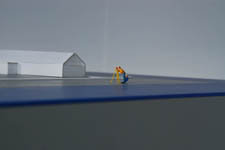Two exhibitions
dal 17/4/2008 al 28/6/2008
Segnalato da
Carlos Amorales
Pierre Bismuth
Michael Borremans
Heather & Patrick Burnett-Rose
Mircea Cantor
Sebastian Díaz Morales
Tessa Farmer
Miklos Gaal
Douglas Gordon
Antony Gormley
Sagi Groner
Nanna Hanninen
Thomas Hirschhorn
Boukje Janssen
Jesper Just
Victor Man
Melik Ohanian
Marilene Oliver
Stephane Pencreac'h
Victor R?c?t?u
Jerome Schlomoff
Speak UP! Tanja Nellemann Poulsen
Grete Aagaard
Yves Tremorin
Emily Bates
Vera Weisgerber
Guido van der Werve
Maria Rus Bojan
Philippe Hardy
Enrico Lunghi
17/4/2008
Two exhibitions
Casino Luxembourg, Luxembourg
"Locked In" intends to initiate a reflection on contemporary representations of man in the context of a continuous expansion of the field of visibility. The contention of this show is that contemporary art provides a powerful tool in trying to understand the complex mutations society is undergoing in the wake of these developments, to the extent that it voices precisely those aspects of reality which elude all other means of expression. Project room: in her photography and video installations, Emily Bates explores the relationship between landscape and humans.

Locked In
Curators: Maria Rus Bojan and Philippe Hardy
Carlos Amorales, Pierre Bismuth, Michaël Borremans, Heather & Patrick Burnett-Rose, Mircea Cantor, Sebastián Díaz Morales, Tessa Farmer, Miklos Gaál, Douglas Gordon, Antony Gormley, Sagi Groner, Nanna Hänninen, Thomas Hirschhorn, Boukje Janssen, Jesper Just, Victor Man, Melik Ohanian, Marilène Oliver, Stéphane Pencréac’h, Victor R?c?t?u, Jérôme Schlomoff, Speak UP! Tanja Nellemann Poulsen & Grete Aagaard, Yves Trémorin, Vera Weisgerber, Guido van der Werve
The exhibition Locked In intends to initiate a reflection on contemporary representations of man in the context of a continuous expansion of the field of visibility.
When speaking of visibility today, one often implies notions of exposure, denudation and intrusion. Whereas in contemporary public discourse, visibility is considered a guarantee for democratic transparency, it also serves to conceal the unconstrained implementation of surveillance techniques and the over-production of power. It is therefore both important and legitimate to investigate the ambivalent meanings and consequences of the democratization of images and the generalization of transparency. The contention of this exhibition is that contemporary art provides a powerful tool in trying to understand the complex mutations society is undergoing in the wake of these developments, to the extent that it voices precisely those aspects of reality which elude all other means of expression.
Locked In thus proposes a different reading of reality, which takes into account that artworks act as “screens of conscience” where the truths and fears haunting the deep strata of collective consciousness appear as if under a magnifying glass. In this view, artworks are not merely accelerators of revelation and meaning but assume the ethical function of unveiling the truth about power strategies and practices at work within contemporary society.
Locked In describes a collective ”syndrome” of our times – the condition of being “locked in” the visible without the possibility or desire to react and change the current state of things. At the same time, it underlines the fact that the contemporary individual has been reduced to the mere functionality of a resource, programmed both as a relay and channel between two modes of visibility and a new “medium” for disseminating messages and information. Rather than a new anthropomorphism or Renaissance, the recurrence of the human figure in contemporary discourse thus signals the paradoxical states of infra-visibility and trans-visibility, of “figurance” and “confinement in the web of the visible” expressed by the metaphor in the title of the exhibition. In reaction to the overabundance of meanings and representations, the exhibition also aims to question the sanity of the present symbolic order, highlighting today’s artists’ endeavour to reconsider the very notions of image and representation.
Locked In presents a selection of 40 outstanding works by 26 artists who work in different media ranging from sculpture, painting and installation to photography and video. The works in this exhibition are centred on contemporary man, who is depicted as an inhabitant of different realities, an “interface to the world”, trapped between the irresistible injunction to multi-task and the need for a unified perception of the world. As archives or manifestos against the disappearance of the subtle and deliberate in our lives, they refer in various ways to this turning point in the history of mankind.
.........................
Emily Bates - love scenes
Project Room
Curator: Enrico Lunghi
In her photography and video installations, Emily Bates explores the relationship between landscape and humans. love scenes originated in audio and visual footage gathered on journeys to the Chinese province of Yunnan. Following a particular interest in the way of life of the native Naxi minority, she renders impressions of a community whose ancient traditions are fading as China swiftly modernises and refocuses itself. At the heart of the work shown at Casino Luxembourg (Project Room) lies the story of two young lovers, who, after having their marriage refused, choose to die on sacred Jade Dragon Snow Mountain. The project’s predominantly documentary style acts as pretext for the creation of a narrative that is ultimately pervaded by sensitivity, nostalgia and a certain exoticism. It is in this way that love scenes attempts to capture the authentic, before it is irretrievably lost.
Opening april 18, 2008
Casino Luxembourg
41, rue Notre-Dame - Luxembourg
Opening Hours:
Monday, Wednesday, Friday from 11 a.m. to 7 p.m.,
Thursday from 11 a.m. to 8 p.m.,
Saturday, Sunday and public holidays from 11 a.m. to 6 p.m.,
Tuesday closed
Regular guided tours:
Saturday 3 p.m. (F)
Sunday 11 a.m. (L), 3 p.m. (F), 4 p.m. (D)
Admission:
Adults: 4 €
Under 26, students, seniors, groups (20 people): 3 €
Under 18: free
Guided tours for groups (max. 20 people): 65 € / guide
Free Admission every Thursday evening at 6 p.m.



